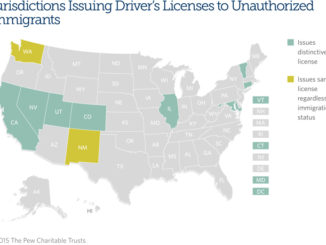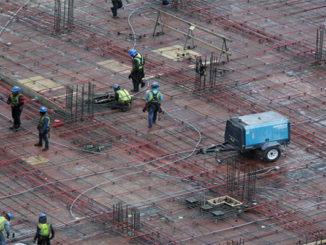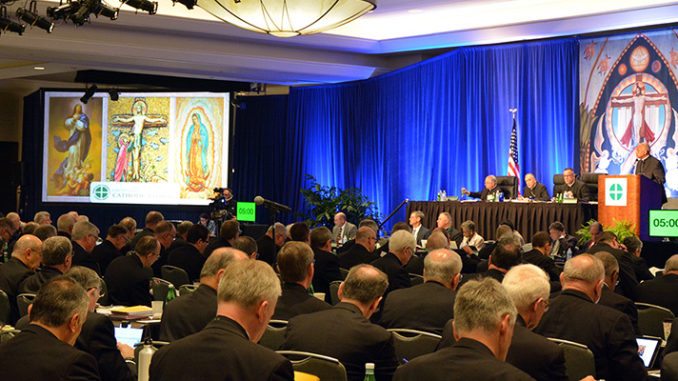
by Alex Gonzalez
The old cliché Republicans want you to believe is that “Latinos are naturally conservative” because they are predominantly Catholic and that they would come to the GOP if they talk about abortion and gay marriage, but that is a myth. And while it is true that Latinos across the southwest are predominantly Catholic, Catholic views about abortion is not a strong issue to woo Latinos to the GOP. Moreover, as the social views of Catholic Latinos change, in line with those of mainline Protestants, Latinos also will be the main ethnic force driving the growth of Catholic Church in the southwest and the nation; and they feel that the Republican Party of Reagan and George W. Bush is dead and perceive the new GOP party of Trump to be anti-Latino and anti-immigrant. More importantly, for the majority of Hispanic/Latino voters, Immigration has become the more “pressing issue” threatening their communities.
Political regional realignments occur through a generation or with a particular issue relevant to a specific voting-bloc living in neighboring states —continuity. Thus, whatever issues are most important for Latinos, will be the determinant factor on how those states will realign as Republicans or Democrats in the southwest.
State continuity is important for realignments because they are made of more than one cultural issue that is important to a single ethnic group residing in neighboring states. Additionally, state continuity is important because most political organizations are created by cultural community centers, businesses, and religious groups from those communities that spread the message through their own venues such churches and cultural centers with similar ‘cleavages”—cultural identity; this is how Jews, Irish, Italians, and Cubans built their political clout within the GOP or Democrat Party. And these cultural and religious “cleavages” can make members of the political Party break away from a Party if one specific issue is not address; and this may even transcend a superficial party identification. So cultural issues are more important than party identification as a Republican or Democrat, and this is the case of Latino voters – who are predominantly Catholics Mexican-American living across 6 or 7 states in the Southwest – that have moved the issue of Immigration to the top of their “most pressing” issues under the Trump administration.
In 2014, the Pew Hispanic Survey on “Latino Issues” education was the number one issue followed by Jobs and the Economy, Health care and Immigration. The Survey showed that:
Since 2007, about one-third of Hispanic registered voters have called immigration an “extremely important” issue to them personally. Even among Hispanic immigrants, the share was 35% in 2012.
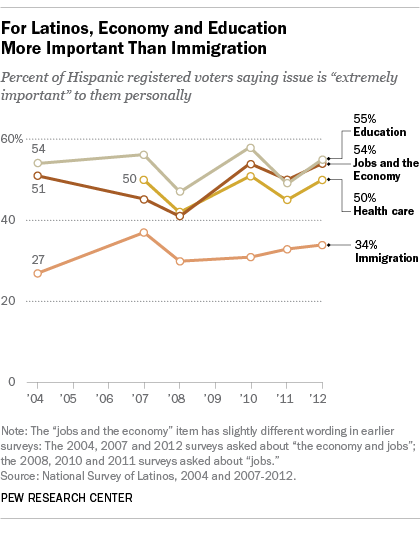
However, by 2018, the same survey showed that, Hispanics who have long been more optimistic, now have become “more dissatisfied with the direction of the U.S.” and that Hispanics now said immigration, economy are the nation’s most pressing problems.” In the 2018 survey, Hispanic voters did not even mention education and Health care as more pressing issues instead, they said “race relations” were among top issues.
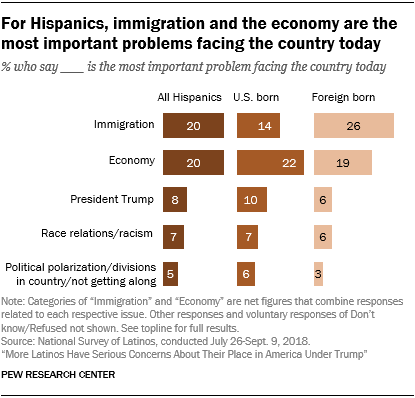
Similarly, several Catholic bishops, for instance, have condemned the administration’s stance on immigration, regarding his proposed border wall and for carrying out family separations along the U.S.-Mexico border. As a result, immigration has becoming a real issues for both Catholics and Hispanics. And for Latinos in the southwest, immigration has become a cross-generational emotional political issue that crosses party lines. Hispanic Republicans are still more likely to take positions that are pro-immigration than Republicans who aren’t Hispanic. For example, 40% of Hispanic Republicans agree that “illegal immigrants should be allowed to stay in the U.S. and obtain citizenship.” The same is true for just 29% of Republicans who aren’t Hispanic. And while it is fact that in states like Arizona and Texas Republicans have been able to keep about 30% of the Latino Vote, these voters tend to be older while Catholic Millennia and younger Latinos are leaning Democrat.

The issue of Immigration has the power to create a new realignment on the issue of immigration across the southwest , because, both Catholic Latinos groups are developing civic and religious support groups across states lines with cultural and historical continuity that is focused on immigration and cultural similarities more than on abortion or even gay marriage. Immigration has become perceived as an attack on Hispanic families, regardless of immigration status. And eve some conservative Latino Evangelical have publicly express that their alliances are to members of their churches, not to the Republican party, or Trump.
Cross-generational views about immigration among Latinos is perceived as a cultural bond for many older generations of Latinos. A study by the University of New Mexico shows that the Political gap narrows between state’s native-born, immigrant Hispanics. According to study by Christine Sierra, UNM professor of political science and director of the Southwest Hispanic Research Institute, people tend to think there’s a major cleavage among Hispanics in New Mexico, between those who are native-born and recent foreign-born arrivals.
These data indicate less cleavage and more consensuses on the politics of immigration in the state,” she said. “I would suggest that we are moving towards a commingling of interests …the increasing immigrant population. There is also another phenomenon, though, that is very important to acknowledge…..That is the existence of mixed-status families. We have families across this country and in this state who are composed of U.S. citizens, permanent residents and undocumented people.
Therefore, regardless of whether 4th or 5th generation, the native interaction with Hispanic immigrants and mixed marriages is increasing the “commingling of interests” between natives and immigrants—regardless of legality—is making immigration a cultural unifying issue overcoming any “cleavages” for Latinos of all background and religious identification. And these unifying views are stronger than views on abortion. Consequently, immigration is the only issue that has the potential to create a new political realignment in the southwest because Latinos will be willing to vote against any party that continues to antagonize Latino communities and oppose an immigration reform.
And while it is a fact the Catholics in America are different than Catholics in Latin America, for a very long time conservative Catholics in America have used social conservative Catholic theology to woo Latinos to the pro-life movement and the fight against gay marriage. However, Trump Immigration policies is changing the priorities for Latino Catholics who are making Immigration their top issue.
Similarly, the “culture wars”are over and more Catholics in America are shifting their views on what was perceived as Catholic social issues doctrine, and Latinos are becoming the main pillar of the American Catholic Church, and soon will be forming a Catholic bloc across 8 western states.
Changing Social Views
The Pew survey of American Catholics shows that :
Nine-in-ten U.S. Catholics say a household headed by a married mother and father is an ideal situation for bringing up children. But the survey shows that large majorities think other kinds of families – those headed by parents who are single, divorced, unmarried or gay – are OK for raising children, too.
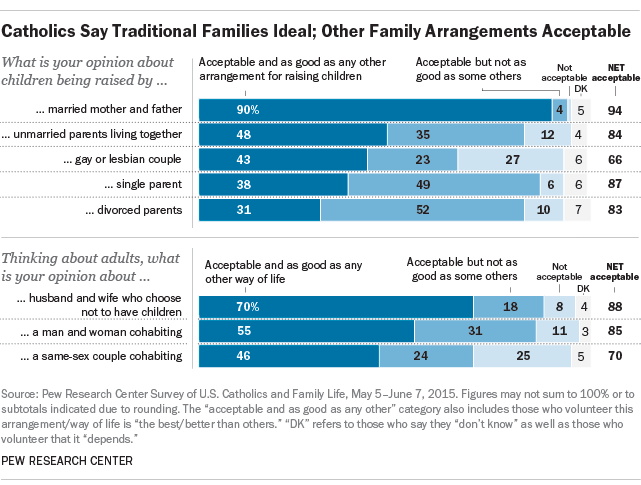
According the Pew Center Survey, “0ne of the strongest factors underlying views of same-sex marriage is religion, and the sense that homosexuality is in conflict with one’s religious beliefs. White evangelical Protestants stand out for their deep opposition to same-sex marriage: Just 27% favor allowing gays and lesbians to marry, while 70% oppose it (43% strongly oppose); by contrast, majorities of both Catholics (56%) and white mainline Protestants (62%) support same-sex marriage, along with an overwhelming majority (85%) of the religiously unaffiliated. and Among Hispanics, 56% says the favor allowing gays and lesbians to marry legally.” Thus, there is consistent trend among American Catholics on the so-called social issues. Therefore, American Latino Catholics, just like mainline Protestants, are becoming more tolerant about abortion and gay marriage.
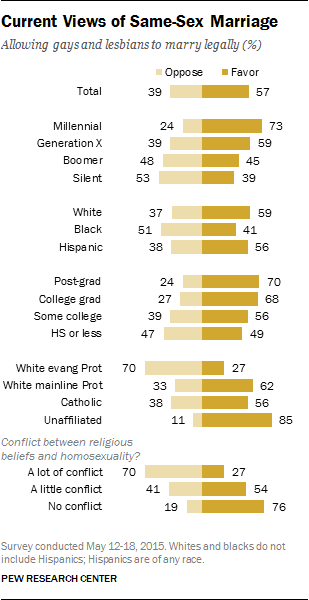
The Latino Catholicization
Latinos are mainly concentrated in Southwestern states where in the next 10 years Latinos will become at least half the population of the states and subsequently, according to the US census by 2042, Latinos will be 80% of the entire southwest from Texas to California. As a result, any the growth of GOP, will happen only outside the East Coast in western states where Latino will soon become the majority. A survey by Gallup in 2016 showed that while the “Most Democrat” states are in the East Coast, with California and New Mexico representing the southwest. Among the “Most Republican” states, these are states scattered across the West, but these are state with small populations.
In the U.S., ethnicity is connected to religiosity and region; it is a ethnicity-religion-region triangulation. For example, According to Robert Putnam’s book American Grace: How Religion Divides us and unites us, when examining the religion and demographic makeup of the nation, all the religious ethnic groups cluster in specific areas. There is an overlapping similarities between the presence of a particular ethnic group and members of an ethnically rooted religions. This overlapping can be seen when we look at the map showing clustering of both ethnic and religious groups. The most visible are those who are self-identified as German-Americans and Lutherans churches. When we look at the map showing a concentration of German-Americans, we can see all 8 states in the upper mid-west populated by “German.” When we look at the population of self-identified Lutherans, 80% of the maps show the same states and counties of that self-Identity as German-Americans, where there are Germans, there Lutherans. And this trend holds up even after many generations have passed.
Also, Putnam argues that there is strong connection between the Scott-Irish and member of the Presbyterian churches who settled in the South predominantly. Thus, there is a strong connection that can be expected between the identity of the Presbyterian church Scott-Irish ethic identity in regions of the South across many states.
Catholics—Irish, Poles , and Italians—settled in mainly in industrial states of the north east and the Catholic map shows overlapping between Italians-Americans Catholic with the greater concentration in Northeast and California. When the map of Latino Catholics is shown the concentration mainly in the 8 states in the Southwest–from Texas to California to Nevada and Colorado—and in south Florida. Here, too, the direct overlapping between the Latinos population and Catholicism is concentrated in one single continuous region is similar to that of ethnic German-Americans and the Lutherans Churches in upper Midwest or the Presbyterian churches with ethnic Scott Irish’s in the South.
This observation by Putman underscores that there is triangulation between religion, ethnicity, and region because groups like to stay together and attend religious services in churches that they are familiar with. But, one little known fact is that, while there has been a “white flight” in the Catholic Church for the last 3 decades, Latinos have been the new pillar of the Catholic Church for the last 2 decades. According to Putnam, Catholics are about 25% of the US population, a proportion that has remained steady for 3 decades. But, American Catholicism has experienced a dramatic change. Over the last 3 decades, “Anglos”—non Latinos—Catholics have been dropping out and disengaging with the Catholic Church. During the same periods, the numbers of Latino Catholics has grown tremendously transforming the American Catholic Church.
According to Putnam, the American Catholic Church was “severely affected” in the 1960s by major reforms in Rome—the Vatican II. Thus, in recent decades as large numbers of ethnic whites Catholics (the grandchildren of early waves of white ethnic Catholics) were slipping out one door of the church, but a large number of Latinos have rushed in through another door. Without the timely arrival of these immigrants and their offspring, the collapse of Catholic mass and Catholicism would have been stepper in America. Thus, the combination of high losses of white ethnic Catholics, a young exodus, and low converts, the only thing that saved the Catholic Church was the arrival of Latino immigrants. The transformation of church was so dramatic that of Catholics ages (18 to 35) 58% are Latinos, and ages (35 to 49) 34% are Latino. This Latino presence within the Catholic Church makes it evident that the future of the church will be linked to the future of Latinos in America. And religious beliefs are linked to ethnicity.
In the past “Catholicization” of the GOP linked the conservative social teaching with the Evangelical pro-life movement and opposition to gay marriage. And that solidified the bond between Conservative Catholic views on social issue and the conservative mantra of the GOP and Evangelical. For example, In an Op-ed on CNN by a Timothy Stanley is a historian at Oxford University argues that:
“There was a time when the Republican Party was strictly for White Anglo Saxon Protestants.” But this year Roughly one-quarter of Republican primary voters are Catholic. Notable Catholic GOP leaders include John Boehner, Paul Ryan, Marco Rubio and Jeb Bush. Six out of nine justices of the Supreme Court are Catholics, and five of them are Republicans. And, the GOP is undergoing a quiet process of Catholicization. It’s one of the reasons why this year’s race has focused so much on social issues.
But the Pro-life movement and opposition to gay marriage has become a small segment of American Catholics. Moreover, Catholic Charities and Churches have always seen parallels between the last great wave of immigrants to the United States, in the late 19th and early 20th centuries, and the current wave of Hispanic/Latinos. Like immigrants now, newcomers in the late 19th and early 20th centuries came from different countries than their predecessors. In 1920, 75% of US Catholics were immigrants, with recent newcomers primarily coming from Southern and Eastern Europe. In response to their needs, the church created or significantly expanded all of its defining institutions, including parishes, schools, charities, hospitals, mutual aid societies, religious communities. For Catholics, the church tried to offer an array of educational, medical, social service, and social institutions that paralleled those of the larger society.
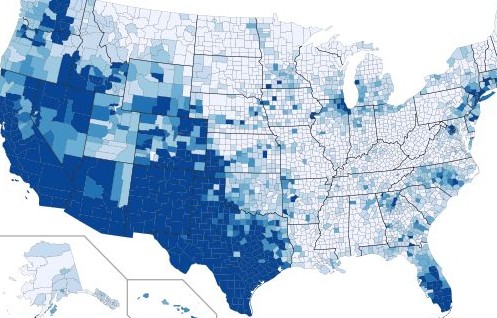
Thus, the social views about abortion and gay marriage continues to evolve among American Latino Catholic while their views on Immigration are similar to those views of Irish and Italians in the 1920s, and for Latinos immigration has become the most pressing issue, especially in the southwest where the growth of Latinos population is occurring.
In Texas, the population will double from 29 million to 50 million in the by 2050, and the 2010 U.S. census estimated that 85% of population growth since 2000 was minority, which happened to be mainly Latino. But in Texas, in 2013, minority births in the state hit 68.5%; and in California Latinos already are almost 40% of the population, 16 million Latinos live in California. Consequently, at this rate, from Texas to California and Colorado, within a generation Latinos will be able to create a new regional bloc that can be converted into triangular realignment argued by Putnam similar to that in South in the 1960-79s when the South moved from Democrat to Republican due to the signing of the Civil Right Legislation.
Furthermore, the obstacles Trump faces with nonwhite Catholics are part of the reason his campaign’s outreach will be heavily concentrated in the Rust Belt — a region that is both disproportionately Catholic and populated by noncollege-educated white voters.
In the second half of Trump’s first term, some white Catholics who originally approved of Trump’s performance have indeed been persuaded to question their support. When Trump took office in January 2017, 48 percent of white Catholics viewed him unfavorably. That figure rose to 52 percent in 2019, according to the PRRI survey, which also found a 9-point drop in the president’s approval rating among white Catholics.
A fall survey by the Public Religion Research Institute, for example, found that only 39 percent of Hispanic Catholics in the U.S. favor restrictions on immigration, which the current administration has sought to curb drastically. At the same time, 68 percent of white Catholics said they favor such policies.
Across all racial groups, health care is the issue most frequently rated as critical, including more than seven in ten black (78%) and Hispanic (71%) Americans, and more than six in ten of other or mixed race Americans (63%) and whites (61%). Beyond that issue, priorities diverge. Among white Americans, the other most critical issues are terrorism (52%) and immigration (48%), aligning them closely with Republicans. Hispanic Americans blend Republican and Democratic issues with majorities saying climate change (64%) and terrorism (59%) are critical. Americans of other or mixed races similarly prioritize climate change (62%) and terrorism (54%). Black Americans most frequently say crime (71%) and fairness of presidential elections (69%) are critical issues.
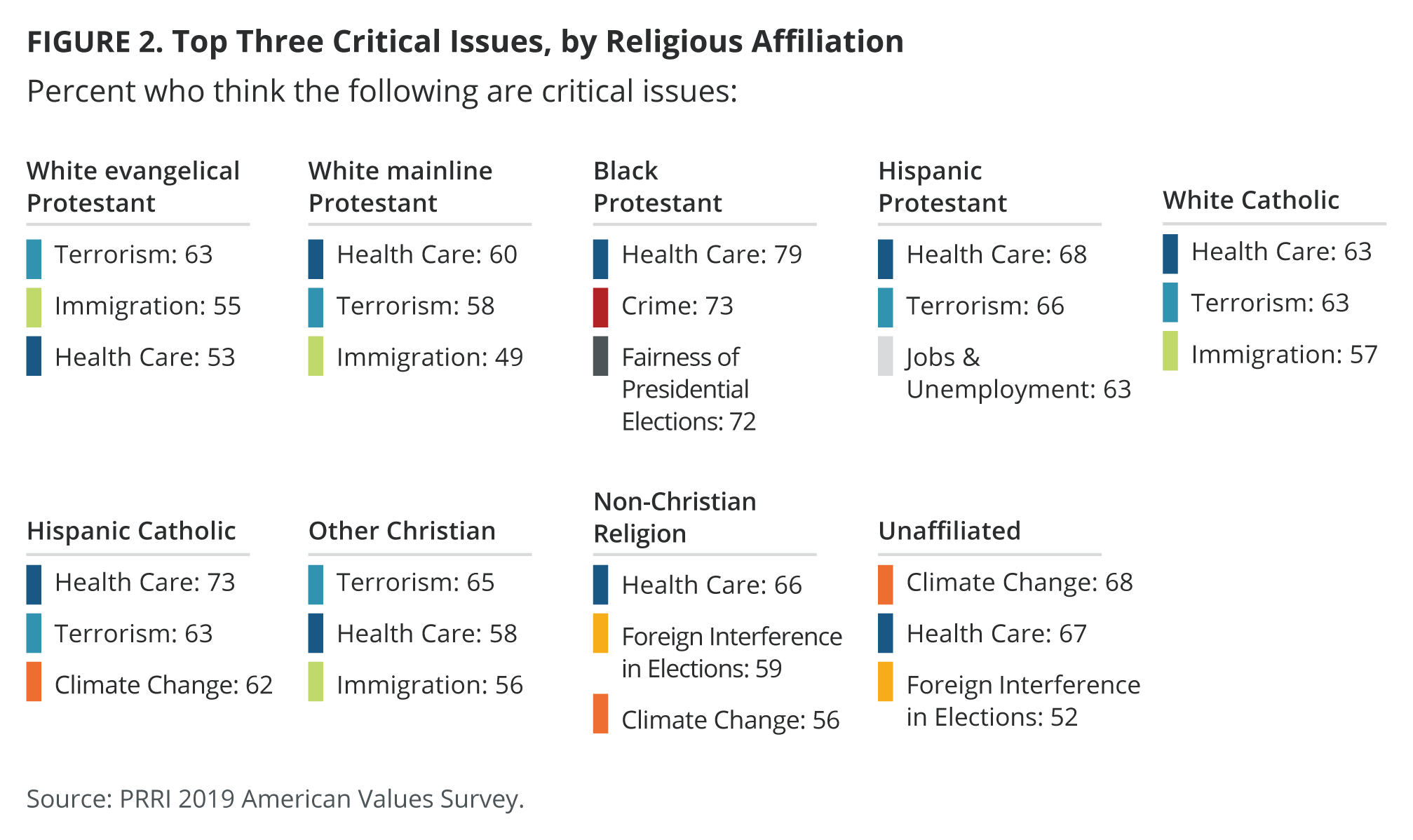
Because American Catholics and Latinos no longer hold the same values on social issues, and with the Trump party hardening their views on Immigration, it is very unlikely that Catholic Latinos, even if they ares conservative, will be wooed by Trump.
Historical perspective
Latinos for the first time in American History are the sole pillar of Catholic Church in the US. Additionally, Latinos will be the majority in the Southwester Corridor from Texas to California—states with largest Electoral Votes and the wealthiest region in the nation.
According to Michael Barone’s Book “The New Americans,” Latinos share the same cultural values of other groups, especially Italians. But what is unique about Latinos is that they share a historical attachment to southwest, especially to areas like Texas, California, and New Mexico where Latinos see themselves as part of the culture of the region, and thus, forming cross-state cultural corridor similar to that of the Jacksonean Scott-Irish corridor in the South.
Republican Party honchos like to argue that Latinos can be wooed by superficial party talk alone about taxes while de-emphasizing their background and the issues of Immigration. However, as with Scott-Irish, the ethnic identity never changes. What changes is the party positions in which the party moves its positions to reflect the values of the groups they seek to represent. Therefore, Latinos won’t change the views just to accommodate GOP party propaganda. It is the Republican Party in the Southwest that needs change to embody the historical, and family values of Latinos.
There are strong cultural values in the Southwest, where Latinos will be majority the next 20 years, Latinos too will be sole bearers of the Catholic Church in the U.S. Though, there is pervasive misconception among the Republican circle that Latinos need to make their ethnic identity less “thick” to be fully embrace by GOP. History shows that ethnic groups strengthen the Political Party when the party formulates the platform around the issues important to a group. This is how the Republic Jacksonean South “Scots-Irish zone” was built. But as Barone points out, it is because of a misconception that Latinos are not like the past wave of immigrants, and a misunderstanding about what it means to be American. Latinos are like any other ethnic groups that want their issues addressed.
Some scholars like Samuel Huntington and Michael Barone have argued that the real meaning of American exceptionalism, or creed, is dedication to a “religious common constitutional civic culture,” that is respect and adherences to the institutions of government created under the Constitution. In fact, Samuel Huntington would have detested the anti-institutionalism of the new Trump party because under Huntington’s views of American-ness, being American meant adherence to institutionalism— institutions created under the US Constitution. Thus, in its purest American form, being an American is respect for Constitution. And Latinos, and Latino culture, have never promoted any non-adherence to a common civic culture, or disrespect for the Constitution.
Like in the South, in the southwest there is greater expression of what Jefferson intended under States Rights; states have the right to have their own culture, and neither the federal government, nor a National Party, have right to impose national culture—or suppress one to favor others–other than a “common civic culture”. Jefferson would have agreed that a few states in the same region have the right to bond together to protect their culture and history, so long as long as it doesn’t conflict with the Constitution. Therefore, Catholic Latinos have the right to insist that their culture be reflected in any political party.
Alex Gonzalez is a political Analyst, Founder of Latino Public Policy Foundation (LPPF), and Political Director for Latinos Ready To Vote. Comments to [email protected] or @AlexGonzTXCA


